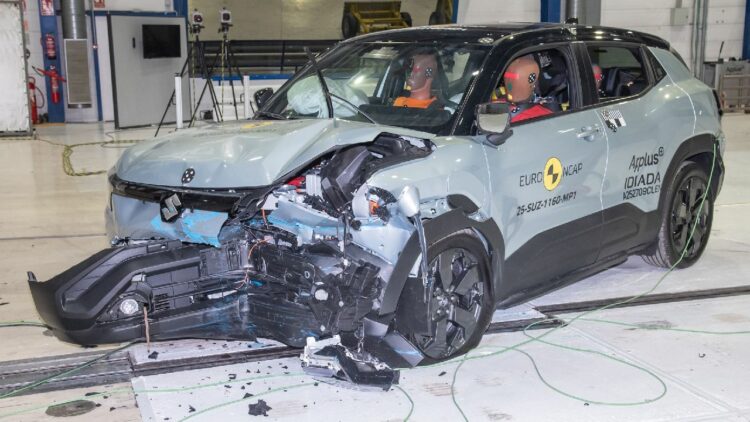The first electric vehicle from the Japanese car marque has shown a promising performance at the Euro NCAP
The made-in-India Maruti Suzuki e Vitara has bagged an impressive 4-star rating at the stringent Euro NCAP. We know that Euro NCAP is among the toughest safety testing assessment agencies globally. The rigorous and thorough testing ensures that all facets of a car’s safety equipment are analysed. Based on that, the final score is awarded. e Vitara first made its debut as the eVX concept back in the 2023 Auto Expo. Throughout last year, the electric SUV was on display in many international markets. Finally, the manufacturing has commenced at Maruti’s Gujarat plant and the shipments have started travelling to Europe.
Maruti Suzuki e Vitara at Euro NCAP
Now, the Maruti Suzuki e Vitara managed to achieve 77% points in the Adult Occupant, 85% points in Child Occupant, 79% in Vulnerable Road Users and 72% in Safety Assist categories. Note that the model tested was the 61 kWh GLX with Left-Hand-Drive configuration. In the frontal offset test, the passenger compartment stayed stable. Dummy readings suggested good protection for the knees and femurs of both the driver and the front passenger. Suzuki also showed that the same level of protection would apply to people of different sizes and seating positions. Analysis of the crash test equipment suggested that the eVitara would be a moderately safe partner in a frontal collision with another car.
| Parameter | Score |
| Adult Occupant Protection | 31/40 |
| Child Occupant Protection | 42/49 |
| Vulnerable Road Users | 50.3/63 |
| Safety Assist | 13/18 |
In the full-width rigid barrier test, the protection of the rear passenger’s head was rated as marginal. This was due to forward movement rather than direct injury risk. Chest protection was also rated as marginal. The car performed strongly in side-impact tests. In both the barrier and pole impacts, it offered good protection to all critical body areas, scoring maximum points. However, control of body movement during far-side impacts was rated as marginal, and the car does not have a feature to reduce occupant-to-occupant injuries in such cases.
For whiplash protection, the results were positive. Tests on the front seats and head restraints showed good protection in rear-end collisions. A check of the rear seats also confirmed good safety in this area. The electric SUV includes several safety systems, such as advanced eCall for emergencies and technology to prevent secondary collisions. Suzuki also proved that doors remain openable if the car becomes submerged in water.
Child Occupant Protection
In both the frontal offset and side barrier crash tests, the car offered good protection to all critical body areas for the 6- and 10-year-old dummies. The e Vitara scored maximum points in this part of the safety assessment. The front passenger airbag can be switched off when needed. This makes it possible to use a rearward-facing child seat in the front passenger position. The system gives clear information to the driver about whether the airbag is on or off, and this feature was recognized in the tests.
However, the car does not include a child presence detection system. This type of system can alert caregivers or bystanders if a child is left in the vehicle, which is becoming an important feature in many modern cars. On a positive note, all types of child restraints designed for the e Vitara could be installed and fitted correctly. This ensures flexibility for different child seat models and provides reassurance for families using the vehicle.
Vulnerable Road Users
The EV has also been assessed for how it protects pedestrians, cyclists, and other vulnerable road users. The results were a mix of good and weak points. Head protection for a pedestrian or cyclist was mostly good or adequate. However, poor results were recorded around the stiff windscreen pillars and at the base and top of the windscreen. Pelvis protection showed mixed outcomes. In contrast, the femur was well protected in all test areas, as were the knee and tibia. The e Vitara comes with an autonomous emergency braking (AEB) system. This system can detect pedestrians, cyclists, and other vehicles.
In pedestrian tests, the system performed at an adequate level, but it does not provide protection for people to the rear of the car. In tests involving cyclists, the system performed well. However, it does not help in “dooring” situations, when a car door is opened into the path of a cyclist coming from behind. The AEB system was also tested for its response to motorcyclists and showed good results. Overall, the e Vitara provides solid basic protection for vulnerable road users, with strengths in lower body safety and cyclist detection. But challenges remain in certain areas, especially around windscreen structures and rear-facing risks.
Safety Assist
The Suzuki e Vitara includes several driver assistance and safety systems. These features were tested to check how well they support safe driving. The autonomous emergency braking (AEB) system showed good performance when reacting to other vehicles. This system helps reduce the risk of collisions by slowing or stopping the car when a crash is likely. Seatbelt reminders are fitted as standard for both front and rear seats. This ensures that all occupants are alerted if they are not wearing their seatbelts.
The car also comes with a driver monitoring system. It can detect signs of fatigue and some types of distraction, warning the driver when attention is reduced. A lane support system is included as well. It gently corrects the car’s path if it begins to drift out of the lane. In more critical cases, the system can intervene more strongly to help avoid accidents. The speed assistance system can recognize local speed limits. Drivers have the option to let the system automatically set the speed limiter based on this information. Together, these technologies aim to reduce human error and increase overall road safety.
Also Read: PM Modi Flags Off Production of First Maruti e Vitara


